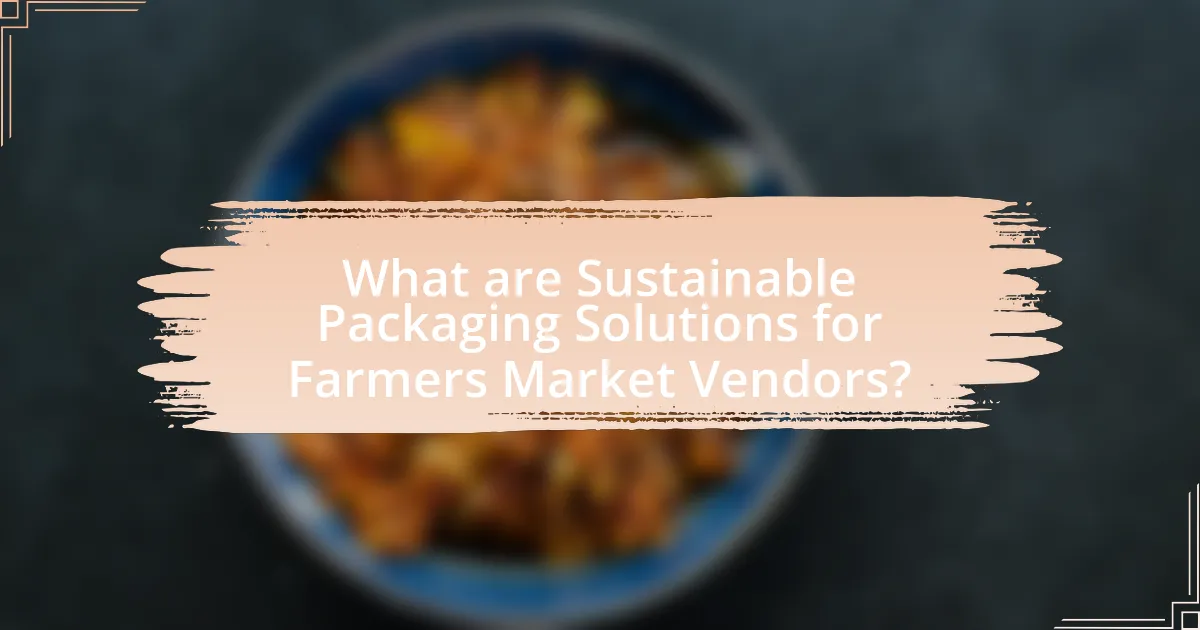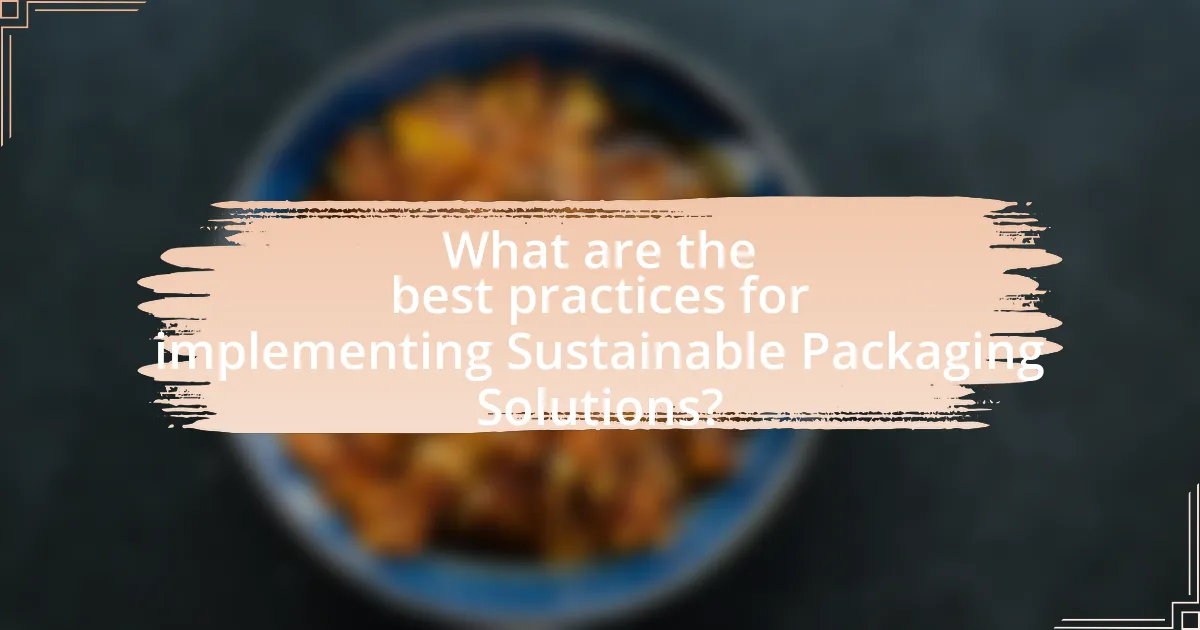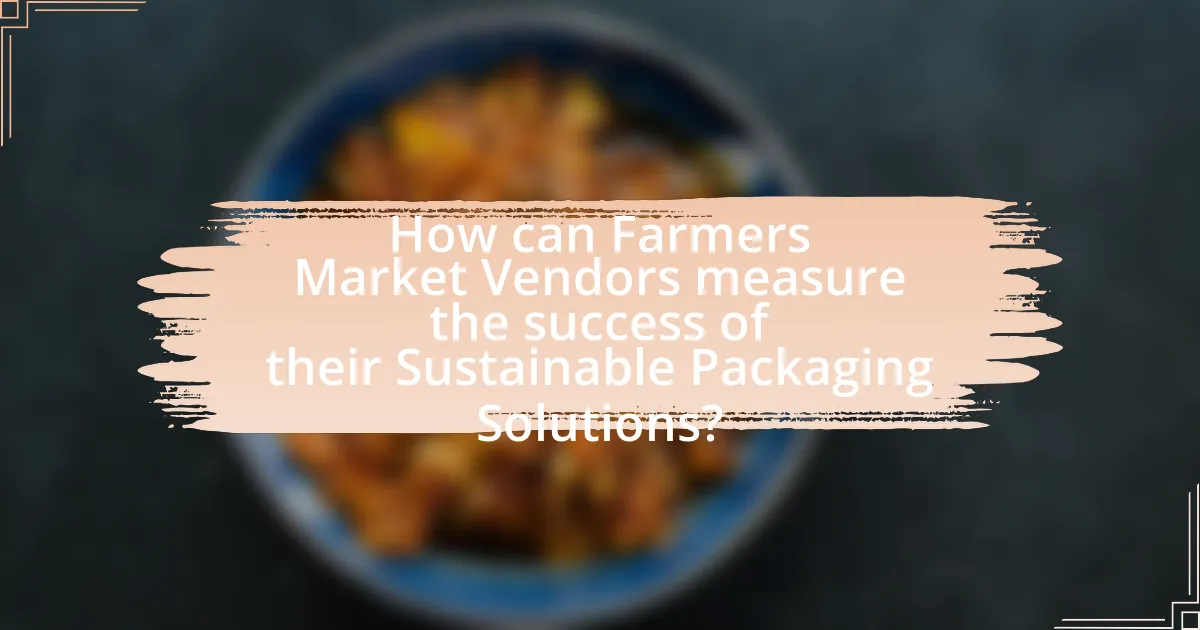Sustainable packaging solutions for farmers market vendors encompass biodegradable bags, compostable containers, and reusable packaging options, all aimed at reducing environmental impact and minimizing plastic waste. These solutions not only align with consumer preferences for eco-friendly products but also enhance brand reputation and customer loyalty. The article explores the benefits of sustainable packaging, the environmental issues it addresses, and the various materials and types available. It also discusses the challenges vendors may face in adopting these solutions, the importance of effective communication with customers, and practical tips for successful implementation. Additionally, it highlights the financial implications and metrics for measuring the success of sustainable packaging initiatives.

What are Sustainable Packaging Solutions for Farmers Market Vendors?
Sustainable packaging solutions for farmers market vendors include biodegradable bags, compostable containers, and reusable packaging options. These solutions reduce environmental impact by minimizing plastic waste and promoting the use of renewable materials. For instance, biodegradable bags made from plant-based materials decompose naturally, while compostable containers can break down in composting facilities, returning nutrients to the soil. Additionally, reusable packaging, such as glass jars or cloth bags, encourages customers to reduce single-use items. According to a study by the Ellen MacArthur Foundation, transitioning to sustainable packaging can significantly decrease plastic pollution and enhance brand loyalty among environmentally conscious consumers.
How do Sustainable Packaging Solutions benefit Farmers Market Vendors?
Sustainable packaging solutions benefit farmers market vendors by reducing environmental impact and enhancing brand reputation. These solutions, such as biodegradable materials and reusable containers, minimize waste and pollution, aligning with consumer preferences for eco-friendly products. Research indicates that 72% of consumers are willing to pay more for sustainable packaging, which can lead to increased sales for vendors. Additionally, using sustainable packaging can differentiate vendors in a competitive market, attracting environmentally conscious customers and fostering loyalty.
What environmental impacts do these solutions address?
Sustainable packaging solutions for farmers market vendors address several environmental impacts, primarily plastic waste reduction, resource conservation, and carbon footprint minimization. These solutions replace single-use plastics with biodegradable or compostable materials, significantly decreasing the volume of plastic that ends up in landfills and oceans. For instance, according to a study by the Ellen MacArthur Foundation, transitioning to sustainable packaging could reduce plastic pollution by 80% by 2040. Additionally, these solutions often utilize renewable resources, which conserves non-renewable materials and reduces energy consumption during production. By adopting sustainable packaging, farmers market vendors can also lower their carbon emissions, contributing to climate change mitigation efforts.
How do these solutions enhance product appeal?
Sustainable packaging solutions enhance product appeal by aligning with consumer preferences for environmentally friendly practices. Research indicates that 72% of consumers are willing to pay more for products with sustainable packaging, demonstrating a clear market demand. Additionally, these solutions often feature attractive designs that emphasize natural materials, which can attract attention and convey quality. By using biodegradable or recyclable materials, farmers market vendors can differentiate their products, fostering a positive brand image and encouraging customer loyalty.
What types of Sustainable Packaging Solutions are available?
Sustainable packaging solutions available include biodegradable materials, compostable packaging, reusable containers, and recyclable packaging. Biodegradable materials, such as plant-based plastics, break down naturally over time, reducing landfill waste. Compostable packaging, made from organic materials, can decompose in composting facilities, enriching soil. Reusable containers, like glass jars or metal tins, can be used multiple times, minimizing single-use waste. Recyclable packaging, often made from paper or certain plastics, can be processed and repurposed, contributing to a circular economy. These solutions are increasingly adopted by farmers market vendors to align with eco-friendly practices and meet consumer demand for sustainable options.
What materials are commonly used in sustainable packaging?
Common materials used in sustainable packaging include recycled paper, biodegradable plastics, glass, and plant-based materials. Recycled paper is favored for its low environmental impact and ability to be repurposed multiple times. Biodegradable plastics, made from renewable resources like cornstarch, decompose more quickly than traditional plastics, reducing landfill waste. Glass is recyclable indefinitely without loss of quality, making it a sustainable choice for packaging. Plant-based materials, such as bamboo and sugarcane, are increasingly used due to their renewability and lower carbon footprint compared to conventional materials. These materials collectively contribute to reducing environmental harm and promoting sustainability in packaging solutions.
How do biodegradable and compostable options differ?
Biodegradable options break down into natural elements over time through the action of microorganisms, while compostable options specifically decompose into nutrient-rich compost under controlled conditions within a composting environment. Biodegradable materials can take varying amounts of time to decompose, depending on environmental factors, whereas compostable materials must meet specific standards, such as ASTM D6400 or EN 13432, to ensure they break down within a set timeframe, typically within 90 to 180 days. This distinction is crucial for sustainable practices, as compostable materials contribute to soil health, while biodegradable materials may not always do so effectively.
Why is it important for Farmers Market Vendors to adopt Sustainable Packaging?
Farmers Market Vendors must adopt sustainable packaging to reduce environmental impact and meet consumer demand for eco-friendly practices. Sustainable packaging minimizes waste, as it is often biodegradable or recyclable, thus contributing to lower landfill contributions. According to a 2021 study by the Ellen MacArthur Foundation, transitioning to sustainable packaging can significantly decrease plastic pollution, which is a pressing global issue. Additionally, consumers increasingly prefer products with sustainable packaging; a 2020 survey by Nielsen found that 73% of global consumers are willing to change their consumption habits to reduce environmental impact. Therefore, adopting sustainable packaging not only aligns with environmental goals but also enhances marketability and customer loyalty for Farmers Market Vendors.
What consumer trends are driving the demand for sustainable packaging?
The demand for sustainable packaging is primarily driven by increasing consumer awareness of environmental issues. Consumers are increasingly prioritizing eco-friendly products, with 72% of Americans willing to pay more for sustainable packaging, according to a 2021 survey by Packaging Digest. This trend is further supported by the rise of eco-conscious brands that emphasize sustainability in their marketing, leading to a shift in purchasing behavior towards products that utilize biodegradable, recyclable, or reusable packaging. Additionally, the growing concern over plastic pollution and its impact on the environment has prompted consumers to seek alternatives that align with their values, reinforcing the demand for sustainable packaging solutions.
How does sustainable packaging align with local farming practices?
Sustainable packaging aligns with local farming practices by promoting environmentally friendly methods that reduce waste and support local economies. This type of packaging often utilizes biodegradable or recyclable materials, which complements the organic and sustainable farming techniques employed by local farmers. For instance, using compostable packaging made from plant-based materials can enhance the sustainability of products sold at farmers’ markets, thereby reinforcing the commitment to eco-friendly practices. Additionally, sustainable packaging can help local farmers differentiate their products in the market, appealing to environmentally conscious consumers and potentially increasing sales.
How can Farmers Market Vendors transition to Sustainable Packaging Solutions?
Farmers market vendors can transition to sustainable packaging solutions by adopting biodegradable, compostable, or reusable materials for their products. This shift not only reduces environmental impact but also aligns with consumer preferences for eco-friendly options. For instance, using materials like plant-based plastics or recycled paper can significantly decrease waste. According to a study by the Ellen MacArthur Foundation, transitioning to sustainable packaging can reduce plastic pollution by up to 80% if widely adopted. Additionally, vendors can collaborate with local suppliers who specialize in sustainable packaging to ensure a consistent supply of eco-friendly materials.
What challenges might Farmers Market Vendors face in adopting these solutions?
Farmers market vendors may face several challenges in adopting sustainable packaging solutions, primarily due to cost, availability, and consumer awareness. The initial investment in eco-friendly materials can be higher than traditional packaging, which may deter vendors operating on tight margins. Additionally, sustainable packaging options may not be readily available in all regions, complicating procurement processes. Furthermore, consumer understanding and demand for sustainable packaging can vary, leading to potential resistance or lack of interest from customers who prioritize price over environmental impact. These factors collectively hinder the widespread adoption of sustainable packaging among farmers market vendors.

What are the best practices for implementing Sustainable Packaging Solutions?
The best practices for implementing sustainable packaging solutions include selecting biodegradable or compostable materials, minimizing packaging size, and utilizing reusable containers. Biodegradable materials, such as plant-based plastics, break down naturally, reducing landfill waste. Minimizing packaging size not only conserves resources but also lowers transportation emissions, as smaller packages require less energy to transport. Reusable containers encourage a circular economy, allowing customers to return packaging for reuse, which further decreases waste. According to a study by the Ellen MacArthur Foundation, transitioning to sustainable packaging can significantly reduce environmental impact, with companies reporting up to a 30% decrease in carbon emissions when adopting these practices.
How can vendors effectively communicate their sustainable practices to customers?
Vendors can effectively communicate their sustainable practices to customers by utilizing clear labeling and transparent messaging about their eco-friendly initiatives. For instance, vendors can display certifications, such as organic or fair trade labels, prominently on their packaging to provide immediate recognition of their sustainable efforts. Additionally, sharing stories about sourcing materials, production processes, and the environmental impact of their practices through signage or social media can enhance customer understanding and trust. Research indicates that 66% of consumers are willing to pay more for sustainable brands, highlighting the importance of effective communication in influencing purchasing decisions.
What labeling strategies can enhance transparency?
Labeling strategies that can enhance transparency include clear ingredient lists, sourcing information, and sustainability certifications. Clear ingredient lists allow consumers to understand what is in the product, fostering trust. Providing sourcing information, such as the origin of ingredients, helps consumers make informed choices about the ethical and environmental impact of their purchases. Sustainability certifications, like USDA Organic or Fair Trade, serve as third-party validations that reinforce the product’s commitment to sustainable practices. These strategies collectively improve consumer confidence and promote informed purchasing decisions in the context of sustainable packaging solutions for farmers market vendors.
How can storytelling about sustainability improve customer engagement?
Storytelling about sustainability can significantly improve customer engagement by creating an emotional connection between the brand and its audience. When farmers market vendors share narratives about their sustainable practices, such as sourcing local materials or reducing waste, they foster a sense of community and shared values. Research indicates that 70% of consumers prefer brands that demonstrate a commitment to sustainability, which enhances loyalty and encourages repeat purchases. By effectively communicating their sustainability efforts through storytelling, vendors can differentiate themselves in a competitive market, leading to increased customer trust and engagement.
What are the cost implications of Sustainable Packaging Solutions?
Sustainable packaging solutions often entail higher initial costs compared to traditional packaging methods. These increased costs arise from the use of eco-friendly materials, which can be more expensive to source and produce. For instance, biodegradable plastics and recycled materials typically have a higher price point due to their manufacturing processes and limited availability. However, long-term savings can be realized through reduced waste disposal fees and potential tax incentives for environmentally friendly practices. According to a study by the Ellen MacArthur Foundation, companies adopting sustainable packaging can enhance brand loyalty and customer retention, which may offset initial costs over time.
How do initial costs compare to long-term savings?
Initial costs for sustainable packaging solutions are typically higher than traditional packaging options, but they lead to significant long-term savings. For example, while biodegradable packaging may cost 20-30% more upfront, it reduces waste disposal costs and can enhance brand loyalty, resulting in increased sales. Studies show that businesses adopting sustainable practices can save up to 50% on waste management costs over time, as they often benefit from reduced landfill fees and potential tax incentives. Thus, the initial investment in sustainable packaging is offset by these long-term financial benefits.
What financial incentives are available for adopting sustainable practices?
Financial incentives for adopting sustainable practices include grants, tax credits, and low-interest loans specifically aimed at promoting eco-friendly initiatives. For instance, the U.S. Department of Agriculture offers various grant programs that support farmers in implementing sustainable practices, such as the Environmental Quality Incentives Program, which provides financial assistance for conservation practices. Additionally, many states provide tax credits for businesses that invest in renewable energy or sustainable technologies, encouraging the transition to greener operations. These incentives not only reduce the financial burden on farmers but also promote long-term sustainability in agricultural practices.

How can Farmers Market Vendors measure the success of their Sustainable Packaging Solutions?
Farmers market vendors can measure the success of their sustainable packaging solutions by tracking customer feedback, sales data, and waste reduction metrics. Customer feedback can be gathered through surveys or direct interactions, allowing vendors to assess consumer satisfaction and preferences regarding packaging. Sales data can indicate whether sustainable packaging influences purchasing decisions, with increased sales potentially reflecting positive consumer response. Additionally, vendors can analyze waste reduction by comparing the amount of packaging waste generated before and after implementing sustainable solutions, with a decrease in waste serving as a clear indicator of success.
What metrics should vendors track to evaluate effectiveness?
Vendors should track metrics such as sales volume, customer feedback, packaging waste reduction, and return on investment (ROI) to evaluate effectiveness. Sales volume indicates the demand for products packaged sustainably, while customer feedback provides insights into consumer satisfaction and preferences regarding packaging. Tracking packaging waste reduction helps vendors assess the environmental impact of their choices, and calculating ROI allows vendors to measure the financial benefits of investing in sustainable packaging solutions. These metrics collectively provide a comprehensive view of a vendor’s effectiveness in implementing sustainable practices.
How can customer feedback be utilized in assessing packaging success?
Customer feedback can be utilized in assessing packaging success by analyzing consumer perceptions and preferences regarding packaging design, functionality, and sustainability. This feedback provides insights into how well the packaging meets customer expectations and its effectiveness in protecting products. For instance, surveys and direct customer interactions can reveal whether the packaging is perceived as eco-friendly, easy to open, or visually appealing. Research indicates that 70% of consumers are more likely to purchase products with sustainable packaging, highlighting the importance of aligning packaging strategies with customer values. By systematically collecting and evaluating this feedback, vendors can make informed adjustments to enhance packaging effectiveness and customer satisfaction.
What role does waste reduction play in measuring success?
Waste reduction is a critical metric for measuring success in sustainable packaging solutions for farmers market vendors. By minimizing waste, vendors can enhance their environmental impact, reduce costs associated with disposal, and improve customer satisfaction through eco-friendly practices. For instance, a study by the Environmental Protection Agency indicates that reducing packaging waste by just 10% can lead to significant cost savings and a lower carbon footprint. This demonstrates that effective waste reduction strategies not only contribute to sustainability goals but also serve as a benchmark for evaluating the overall success of vendors in adopting sustainable practices.
What practical tips can Farmers Market Vendors follow for successful sustainable packaging?
Farmers Market Vendors can achieve successful sustainable packaging by utilizing biodegradable materials, such as compostable bags and containers, which decompose naturally and reduce landfill waste. Additionally, vendors should prioritize reusable packaging options, encouraging customers to bring their own containers or offering incentives for returns. Implementing minimalistic packaging designs can also reduce material usage while maintaining product integrity. Research indicates that 60% of consumers prefer eco-friendly packaging, highlighting the market demand for sustainable practices. By adopting these strategies, vendors not only contribute to environmental sustainability but also align with consumer preferences, enhancing their market appeal.